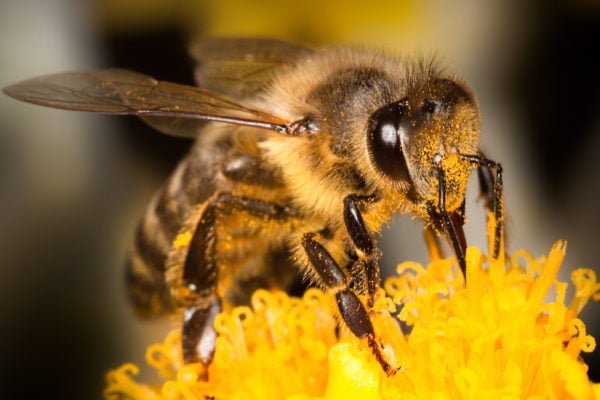When it comes to pest control, we recognize that some pests are simply too dangerous to go unaddressed. A mischief of infected deer mice nesting in your home could transmit the aerosolized virus Hantavirus pulmonary syndrome (HPS), posing a serious risk to your family’s respiratory health. A cargo shipment from one continent to another inadvertently transporting an insect that has no natural predator at the final destination could wipe out crops, such as the case when the Spotted Lanternfly – native to China – was discovered in Pennsylvania in 2014. Plenty of insects and wildlife tote a venomous bite or stinger that can be lethal to humans. The bottom line: pest control is essential.
But at the same time, some pests are essential. Weird, right?
Take, for example, the subject of the blog and our friend, the honeybee. Honeybees – along with other pollinators like birds, bats, and some small mammals – help sustain our ecosystem and natural resources by helping plants reproduce. It’s estimated that 75% to 95% of all flowering plants need help with pollination. Bee pollination alone adds approximately $14 billion annually to improved crop yield and quality(1), and is responsible for 1 in 3 bites of food(2). So, without these little guys, it’s fair to say we would be in a great deal of trouble.
It’s no secret in recent years that honeybee populations have been declining, sparking action from government entities like the EPA and industry experts such as the National Pest Management Association (NPMA). The EPA has vigorously studied the effects of various pesticides that resulted in language about pollinators being added to the labels of some neonicotinoid pesticide products and endorsing guidance documents from the Association of Structural Pest Control Regulatory Official (ASPCRO). The NPMA took steps towards providing Pollinator Protection Training and launching pollinatorhealth.org, with great FAQ guides about improper pesticide use and other threats to pollinator health. These practices are nothing new either, as entomologists and ecologists have put emphasis on Integrated Pest Management systems since the 1970s. Just as we’ve learned with many of the scientific discoveries in the past 50 years, continued education and research are required to fully understand the problem.
With all the knowledge at hand so far, and all the buzz (couldn’t resist) still surrounding honeybees, the question shifts to, “what are pest control companies doing to further protect honeybees?”
We’re glad you asked!
At Plunkett’s, our stance is pretty simple: whenever possible, we leave bees alone. Each of our more than 400 field technicians go through extensive training, licensing and certification processes in the respective states to recognize bee activity, habitats, and opportunities to preserve their lives. This training is continuous, as recertification takes place annually in many states with multiple refresher courses in between. A highly knowledgeable and well-trained professional is the first step to ensuring that pest control remains effective against dangerous pests and not the insects providing innumerous benefits to our ecosystem.Plunkett’s also acknowledges the following 3 situations that can cause people to request honeybee control:
- Honeybee Swarms. Though a mass of buzzing bees can appear threatening, a swarm poses almost no risk to casual observers. Swarms form when a portion of an existing colony flies off to find a new nest site. Swarms may rest temporarily on structures but will move on within hours. If a swarm occurs in a busy area, it can be cordoned off and left alone. As such, we suggest contacting a beekeeper, who may want to come and collect the swarm to rear the bees. We use the website www.beeremovalsource.com to refer beekeepers by state.
- Allergies. A very small percentage of the population is allergic to honeybee venom. Allergic responses to stings can be life-threatening. If an allergic person discovers a colony located close enough to pose a risk, the preferred solution is to call a beekeeper. Again, the website www.beeremovalsource.com becomes an excellent resource to safely move the bees. If none can be found, the colony can be treated.
- Colonies in Structural Voids. Honeybees sometimes build a colony inside the wall of a home or office building, which is undesirable. If a beekeeper can be persuaded to remove the colony, that is the preferred solution. If a beekeeper isn’t available or if the caller insists on immediate action, the colony can be treated. Whatever solution is found, once all the bees have been removed, a contractor will be needed to eliminate the wax, stored honey, and other remnants of the colony.
Keeping Pest Control Essential
While we remain a fervent advocate for honeybees and any support we can provide to ensure colonies do not collapse, we will also remain an advocate for our clients who recognize the unmistakable need for pest control services. We trust the scientists and leaders to put forth the best action plan to meld the two worlds together, just as our customers have trusted us for over 100 years to do our job and do the right thing. Reach out to the professionals at Plunkett’s today to learn more about pollinators and what our experts can do to help!
(1). Robert Wolf, NASA, 2016(2). Task Force of Systemic Pesticides, 2014








